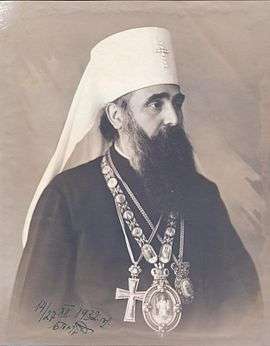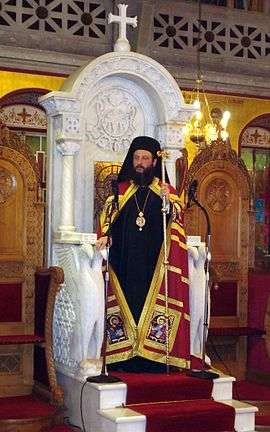Metropolitanate of Skopje
| Metropolitanate of Skopje Митрополија скопска Μητρόπολις Σκόπιάς | |
|---|---|
| Location | |
| Territory | Region of Skopje |
| Headquarters |
Skopje Republic of Macedonia |
| Information | |
| Denomination | Eastern Orthodox |
| Sui iuris church | Serbian Orthodox Church – autonomous Orthodox Ohrid Archbishopric |
| Established | 4th Century |
| Language | Church Slavonic |
| Current leadership | |
| Bishop | Jovan Vraniškovski (2002–present) |
| Website | |
| Metropolitanate of Skopje | |
-en.svg.png)


Metropolitanate of Skopje (Serbian: Митрополија скопска; Greek: Μητρόπολις Σκόπιάς) is an Eastern Orthodox Eparchy, currently under the jurisdiction of the Orthodox Ohrid Archbishopric, an autonomous and canonical branch of the Serbian Orthodox Church in the Republic of Macedonia. Its seat is in Skopje. It is a Metropolitan diocese of the Orthodox Ohrid Archbishopric, headed by Archbishop Jovan Vraniškovski of Ohrid, who is also styled: Metropolitan of Skopje.[1]
History
The see of Skopje is one of the oldest sees in the region. Modern name of the city of Skopje was derived from the name of its predecessor, the ancient Roman city of Scupi.[2] It was one of the most important cities in the Roman province of Moesia Superior and since the end of the 3rd century the capital of its successor province of Dardania.[3] The ancient Bishopric of Scupi was situated near the modern town of Skopje where the remains of episcopal Basilica have been found and excavated. The exact date of the foundation of Bishopric of Scupi is not known, but it already existed by the beginning of the 4th century. In that time, Bishop of ancient Scupi was alsto the Metropolitan of Dardania.[4]
After the division of the Roman Empire in 395, the city of Scupi with rest of Dardania remained part of the Eastern Roman or Byzantine Empire.[5] Up to the beginning of the 6th century, episcopal see of Scupi was already under supreme ecclesiastical jurisdiction of Archbishopric of Thessaloniki. In 535, by the decree of emperor Justinian I (527–565), it was transferred to newly created Archbishopric of Justiniana Prima. Byzantine rule in that region finally collapsed at the beginning of the 7th century and the church life was later renewed after the Christianization of Serbs.[6]
After the successful Byzantine campaigns of 1018 and the reestablishment of imperial rule in Bulgarian and Serbian lands, by the order of emperor Basil II an autonomous Archbishopric of Ohrid was created in 1019, under the supreme ecclesiastical jurisdiction the Ecumenical Patriarchate of Constantinople.[7] Imperial charters of 1019 and 1020 mention the Bishopric of Skopje among eparchies under the jurisdiction of the Archbishopric of Ohrid.[8] In 1282, region of Skopje was incorporated into Kingdom of Serbia and the see of Skopje was placed under the jurisdiction of Serbian Orthodox Church.[9][10][11] In 1346, Bishop of Skopje was granted the honorary title of Metropolitan, on the occasion of the proclamation of Serbian Patriarchate.[12] In 1392, the city was conquered by Ottoman Turks[13] and soon after the see was returned under the jurisdiction of Archbishopric of Ohrid.[14]
In 1557, when Serbian Patriarchate of Peć was restored, the Metropolitanate of Skopje was returned under its ecclesiastical jurisdiction.[15][16] Epachy of Skopje was one of the most important sees of the Serbian Patriarchate. In 1711, Metropolitan Atanasije I of Skopje was elected Serbian Patriarch. In 1747, Metropolitan Atanasije II of Skopje was also elected Serbian Patriarch. Since 1766, when Serbian Patriarchate was abolished, the Eparchy of Skopje came under the jurisdiction of Ecumenical Patriarchate of Constantinople. In 1912, Serbian army liberated Skopje from Ottoman rule.[17] Soon after that negotiations were initiated with Patriarchate of Constantinople and in 1920 entire region was again returned to the jurisdiction of Serbian Orthodox Church.[18] In 1930, Metropolitan Varnava Rosić of Skopje was elected Serbian Patriarch.
In 1959, Serbian Orthodox Church granted ecclesiastical autonomy to eparchies in Republic of Macedonia. After the unilateral and uncanonical proclamation of autocephaly of Macedonian Orthodox Church in 1967, ecclesiastical order was disrupted for a long time. When Republic of Macedonia proclaimed its independence from Yugoslavia in 1992, Serbian Orthodox Church decided to place all eparchies in FYRM under special administration. In 1993, auxiliary bishop Jovan Mladenović of Tetovo (in the region of Polog near Skopje) was appointed administrator of all eparchies in the Republic of Macedonia. Next year, he was transferred to another see and administration of eparchies in FYRM was given to Bishop Pahomije Gačić of Vranje. In 2002, Eparchy of Skopje was placed under the administration of Bishop Jovan Vraniškovski of Veles, as an Exarch of the Serbian Patriarch. In 2005, he was confirmed as Archbishop of Ohrid and Metropolitan of Skopje.[19]
Heads
Early Bishops of ancient Scupi (Dardania)
| Name | Original name in Greek | Notes |
|---|---|---|
| Dacus | Δάκος | Attended First Council of Nicaea in 325.[20] |
| Paregorius | Παρηγόριος | Attended Council of Serdica in 343.[20] |
| Ursilius | Ουρσίλιος | Mentioned in 458, in a letter of Emperor Leo I.[20] |
| Johannes | Ιωάννης | Mentioned from 490 to 495, in letters of Pope Gelasius I.[20] |
Metropolitans of Skopje (since 1766, list incomplete)
| Picture | Name (Tenure) |
Notes |
|---|---|---|
| Anthimos (1767—1775) | Άνθιμος | |
| Zacharias (1775—1799) | Ζαχαρίας | |
| Anthimos (1799—1820) | Άνθιμος | |
| Joasaph (1820—1823) | Ιωάσαφ | |
| Ananias (1823—1828) | Ανανίας | |
| Neophytos (1828—1830) | Νεόφυτος | |
| Gennadios (1831—1832) | Γεννάδιος | |
| Gavril (1832—1843) | Γαβριήλ (d. 1843) | |
 |
Joachim (1844—1868) | Ιωακείμ (d. 1868) |
 |
Paisios (1868—1891) | Παΐσιος (d. 1891) |
| Methodios Papaemmanouil (1891—1896) | Μεθόδιος Παπαεμμανουήλ (d. 1896) | |
| Amvrosios Stavrianos (1896—1899) | Αμβρόσιος Σταυρινός (b. 1854 - d. 1931) | |
 |
Firmilijan Dražić (1902—1903) | Фирмилијан Дражић (Serbian) |
| Sevastijan Debeljković (1904—1905); | Севастијан Дебељковић (Serbian) | |
| Vićentije Krdžić (1905—1915) | Вићентије Крџић (Serbian). Murdered by Bulgarians in 1915 | |
 |
Varnava Rosić (1920—1930) | Варнава Росић (Serbian) |
 |
Josif Cvijović (1932—1957) | Јосиф Цвијовић (Serbian) |
| Dositej Stojković (1959—1967) | Доситеј Стојковић. Since 1967, head of self-proclaimed "Macedonian Orthodox Church" | |
| Jovan Mladenović 1993—1994 | Administrator | |
| Pahomije Gačić 1995—2002 | Administrator | |
 |
Jovan Vraniškovski (since 2005) | Orthodox Ohrid Archbishopric |
See also
References
- ↑ Biography of the Archbishop of Ohrid and Metropolitan of Skopje
- ↑ Papazoglu 1978, p. 198-251.
- ↑ Petrović 2007, p. 11, 16–17, 19, 23.
- ↑ Harnack 1905, p. 371, 375.
- ↑ Mócsy 2014, p. 350.
- ↑ Curta 2001, pp. 125, 130.
- ↑ Stephenson 2000, pp. 74–75.
- ↑ Bulić 2013, pp. 221–222.
- ↑ Slijepčević 1958, pp. 60–61.
- ↑ Fine 1994, pp. 261.
- ↑ Ćirković 2004, pp. 49, 51.
- ↑ Ćirković 2004, pp. 64.
- ↑ Fine 1994, pp. 412.
- ↑ Ćirković 2004, pp. 86, 92, 102.
- ↑ Slijepčević 1958, pp. 77–78.
- ↑ Sotirović 2011, pp. 143–169.
- ↑ Ćirković 2004, pp. 245.
- ↑ Kiminas 2009, pp. 22, 28.
- ↑ Tomos on the church autonomy of the Orthodox Ohrid Archbishopric
- 1 2 3 4 Zeiller 1918, pp. 160–161, 599.
Sources
- Harnack, Adolf (1905). The Expansion of Christianity in the First Three Centuries. 2. New York: Putnam's Sons.
- Zeiller, Jacques (1918). Les origines chrétiennes dans les provinces danubiennes de l'Empire romain. Paris: E. De Boccard.
- Slijepčević, Đoko M. (1958). The Macedonian Question: The Struggle for Southern Serbia. Chicago: The American Institute for Balkan Affairs.
- Papazoglu, Fanula (1978). The Central Balkan Tribes in pre-Roman Times: Triballi, Autariatae, Dardanians, Scordisci and Moesians. Amsterdam: Hakkert.
- Јанковић, Марија (1985). Епископије и митрополије Српске цркве у средњем веку (Bishoprics and Metropolitanates of Serbian Church in Middle Ages). Београд: Историјски институт САНУ.
- Грујић, Радослав (1993). Азбучник Српске православне цркве. Београд: БИГЗ, Музеј СПЦ.
- Fine, John Van Antwerp Jr. (1994). The Late Medieval Balkans: A Critical Survey from the Late Twelfth Century to the Ottoman Conquest. The University of Michigan Press.
- Вуковић, Сава (1996). Српски јерарси од деветог до двадесетог века (Serbian Hierarchs from the 9th to the 20th Century). Евро, Унирекс, Каленић.
- Stephenson, Paul (2000). Byzantium's Balkan Frontier: A Political Study of the Northern Balkans, 900–1204. Cambridge University Press.
- Curta, Florin (2001). The Making of the Slavs: History and Archaeology of the Lower Danube Region, c. 500–700. Cambridge: Cambridge University Press.
- Pavlowitch, Stevan K. (2002). Serbia: The History behind the Name. London: Hurst & Company.
- Popović, Svetlana (2002). "The Serbian Episcopal sees in the thirteenth century (Српска епископска седишта у XIII веку)". Старинар (51: 2001): 171–184.
- Ćirković, Sima (2004). The Serbs. Malden: Blackwell Publishing.
- Curta, Florin (2006). Southeastern Europe in the Middle Ages, 500–1250. Cambridge: Cambridge University Press.
- Petrović, Vladimir P. (2007). "Pre-Roman and Roman Dardania: Historical and Geographical Considerations" (PDF). Balcanica. Balkanološki institut SANU. no. 37: 7–23.
- Kiminas, Demetrius (2009). The Ecumenical Patriarchate: A History of Its Metropolitanates with Annotated Hierarch Catalogs. Wildside Press LLC.
- Sotirović, Vladislav B. (2011). "The Serbian Patriarchate of Peć in the Ottoman Empire: The First Phase (1557–94)". Serbian Studies: Journal of the North American Society for Serbian Studies. 25 (2): 143–169.
- Bulić, Dejan (2013). "The Fortifications of the Late Antiquity and the Early Byzantine Period on the Later Territory of the South-Slavic Principalities, and their re-occupation". The World of the Slavs: Studies of the East, West and South Slavs: Civitas, Oppidas, Villas and Archeological Evidence (7th to 11th Centuries AD). Istorijski institut SANU. pp. 137–234. ISBN 978-86-7743-104-4.
- Mócsy, András (2014) [1974]. Pannonia and Upper Moesia: A History of the Middle Danube Provinces of the Roman Empire. New York: Routledge.